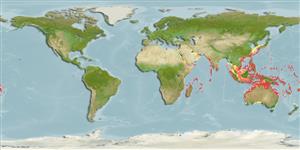| Native range | All suitable habitat | Point map | Year 2100 |

|
| This map was computer-generated and has not yet been reviewed. |
| Pristotis obtusirostris AquaMaps Data sources: GBIF OBIS |
Human uses
Fisheries: subsistence fisheries; aquarium: commercial
Phylogenetic diversity index
(Ref. 82805)
PD50 = 0.7500 many relatives (e.g. carps) 0.5 - 2.0 few relatives (e.g. lungfishes)
Trophic Level
(Ref. 69278)
3.5 ±0.51 se; Based on food items.
Resilience
(Ref. 69278)
High, minimum population doubling time less than 15 months (K=0.8)